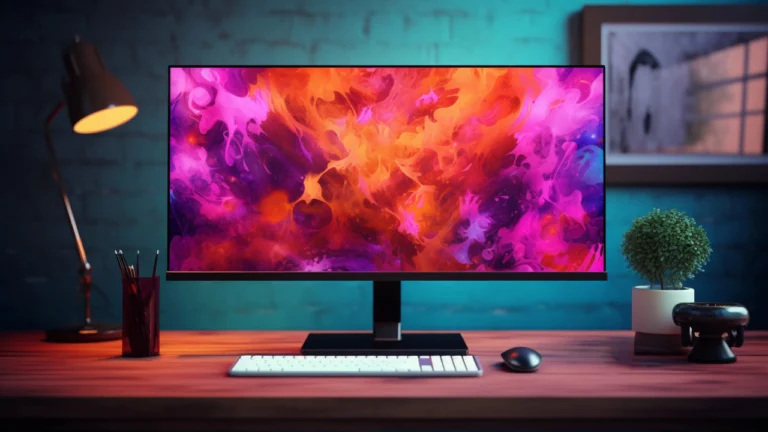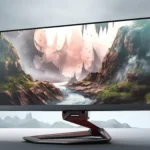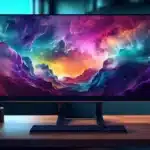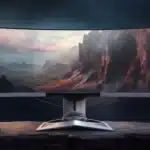What Screen Curvature Actually Means (1000R vs 1800R Explained)

Curved monitors have become increasingly popular over the past few years. Whether you’re a gamer, a creative professional, or someone who spends long hours in front of the computer, the appeal of curved screens is clear: they promise better immersion, reduced eye strain, and a more comfortable viewing experience. But when you start shopping for one, you’ll encounter terms like 1000R, 1800R, and various other curvature ratings. What do these numbers actually mean? And how do they impact your viewing experience?
In this article, we’ll break down the concept of screen curvature, explain the difference between 1000R and 1800R, and help you understand how to pick the right curve for your setup. Plus, if you want to explore the top curved monitors on the market, check out this comprehensive best curved computer monitor guide.
What is Screen Curvature?
Screen curvature describes how much a curved monitor bends inward. It’s measured by the radius of the circle that the curve would form if it extended into a complete circle.
The letter R stands for radius.
The number before the R indicates the radius of the curve in millimeters.
For example:
1000R means the monitor curves along the arc of a circle with a radius of 1000 millimeters (or 1 meter).
1800R means the curve is part of a circle with an 1800-millimeter radius (1.8 meters).
The smaller the number, the more pronounced or tighter the curve. A 1000R monitor will have a sharper curve than an 1800R monitor.
Why Does Curvature Matter?
Understanding curvature is essential because it affects:
Immersion: How much the screen wraps around your field of vision.
Eye Comfort: How naturally your eyes can take in the entire screen.
Viewing Angles: How consistent colors and details look across the screen.
Desk Space and Setup: How a curved monitor fits in your workspace.
The curvature needs to complement how far you sit from the monitor. A curve that’s too tight or too flat for your viewing distance may cause discomfort or defeat the purpose of buying a curved screen.
Breaking Down 1000R and 1800R Curvature
What Does 1000R Mean?
1000R curvature means the display’s curve forms a circle with a radius of 1 meter.
This is the tightest curve available in consumer monitors today.
It is designed to closely match the natural curvature of the human eye.
The goal is to create an immersive experience that makes the screen feel like it surrounds your field of view.
Advantages of 1000R:
Enhanced immersion — feels like the monitor wraps around your vision.
Less eye movement — your eyes don’t have to shift as much to see the edges.
Reduced distortion and glare on curved surfaces.
Perfect for gaming setups, especially if you sit close (20-30 inches) to your screen.
Helps with reducing eye strain during extended use.
Potential Drawbacks:
Might feel too curved for some users who prefer a more subtle bend.
Not ideal if you sit far from the monitor (more than 30 inches), as the curve can feel exaggerated.
Can take up more desk space in depth compared to flatter monitors.
What Does 1800R Mean?
1800R curvature means the screen is curved along a circle with a radius of 1.8 meters.
This is a gentler, more subtle curve compared to 1000R.
It’s a very common curvature rating for many curved monitors.
Advantages of 1800R:
Provides a comfortable viewing experience without feeling too “wrapped in.”
Suitable for a wider variety of viewing distances, including setups where you sit a bit further back.
Often preferred for office work and general productivity.
Still offers some immersion benefits without being overwhelming.
Compatible with ultrawide screens, where a subtle curve balances size with comfort.
Potential Drawbacks:
Less immersive than 1000R.
May not reduce eye strain as effectively for very close viewing.
For gaming, might feel less engaging than a tighter curve.
How to Decide Between 1000R and 1800R?
1. Consider Your Viewing Distance
The most important factor when choosing curvature is how far you sit from your monitor.
If you sit very close (about 20 to 30 inches away), a 1000R curved monitor will match your field of vision more naturally and offer a more immersive, comfortable experience.
If you sit further back (30+ inches), an 1800R curved monitor is a better fit since the gentler curve won’t distort your viewing angles or feel excessive.
2. Usage Type
Gaming: 1000R is generally preferred for immersive single-player or racing simulators. The tight curve wraps the scene around your view, pulling you into the action.
Productivity & Office Work: 1800R often strikes a nice balance between immersion and comfort without overwhelming your desk space or your eyes.
Creative Work: Depending on the size and resolution, 1800R is more common here, but some professionals enjoy 1000R for ultrawide monitors to maximize their visual workspace.
3. Desk Space & Setup
Curved monitors, especially those with tighter curves like 1000R, tend to be deeper from front to back. Make sure your desk can accommodate the monitor comfortably without compromising your sitting posture.
4. Personal Preference
While technical specs matter, personal preference is king. Some users love the sensation of being surrounded by a 1000R curve. Others find it disorienting or simply prefer the gentler 1800R curve.
If possible, try to test monitors with different curvatures in-store or watch detailed video reviews online before deciding.
Other Curvature Ratings You May Encounter
Besides 1000R and 1800R, you might see other numbers like 1500R, 3000R, or even flatter curves labeled as 4000R.
1500R: Midway between 1000R and 1800R, offers a balance for users who want some immersion but don’t want an intense curve.
3000R or higher: Very subtle curves, often found in ultrawide office monitors designed for multitasking and general use.
How Curvature Affects Eye Comfort and Immersion
Your eyes naturally view the world in a curved field, so curved screens attempt to mimic this shape to provide a more natural experience. This reduces the need for your eyes to constantly refocus and shift, which is common on large flat screens.
The closer the curvature matches your eye’s natural field, the less eye strain you experience during long work or gaming sessions.
With a well-matched curvature, peripheral distortion is minimized, and colors/brightness remain more consistent across the screen. This is especially noticeable on larger monitors, where flat screens can cause stretching or warping of the edges.
Common Misconceptions About Curved Monitors
“Curved monitors are only for gamers.”
False. While gamers benefit greatly, curved monitors are increasingly used by professionals, stock traders, video editors, and anyone who spends a lot of time at a computer.“More curve is always better.”
Not true. The best curve depends on viewing distance, screen size, and use case.“Curved monitors are harder to mount or use multi-monitor setups with.”
Curved monitors can be mounted with standard VESA mounts, and some ultrawide curved monitors can replace dual-monitor setups.
Which Curved Monitor Should You Buy?
Now that you understand the difference between 1000R and 1800R curvature, the next step is finding the perfect monitor for your needs. There are plenty of excellent options on the market, ranging from budget-friendly models to high-end professional displays.
If you want a trusted, comprehensive guide to the best curved computer monitors available today, take a look at WiredTech’s curated list of the best curved computer monitors. It covers different sizes, resolutions, refresh rates, and curvatures, helping you choose a monitor that fits your budget and setup perfectly.
Final Thoughts
Screen curvature might seem like a small technical detail, but it makes a significant difference in how comfortable and immersive your monitor feels. Understanding the difference between 1000R and 1800R curvature will help you pick a monitor that matches your viewing habits and workspace.
If you want maximum immersion and sit close to your screen, 1000R is the way to go.
If you prefer a more subtle curve and a versatile setup, 1800R is a great choice.
No matter what you pick, curved monitors offer a modern, eye-friendly alternative to flat screens that’s here to stay.
Feel free to explore detailed reviews and buying tips on the best curved computer monitor guide and find the perfect curve for your next setup!
If you want me to add image suggestions or help format this for your blog, just say the word!






